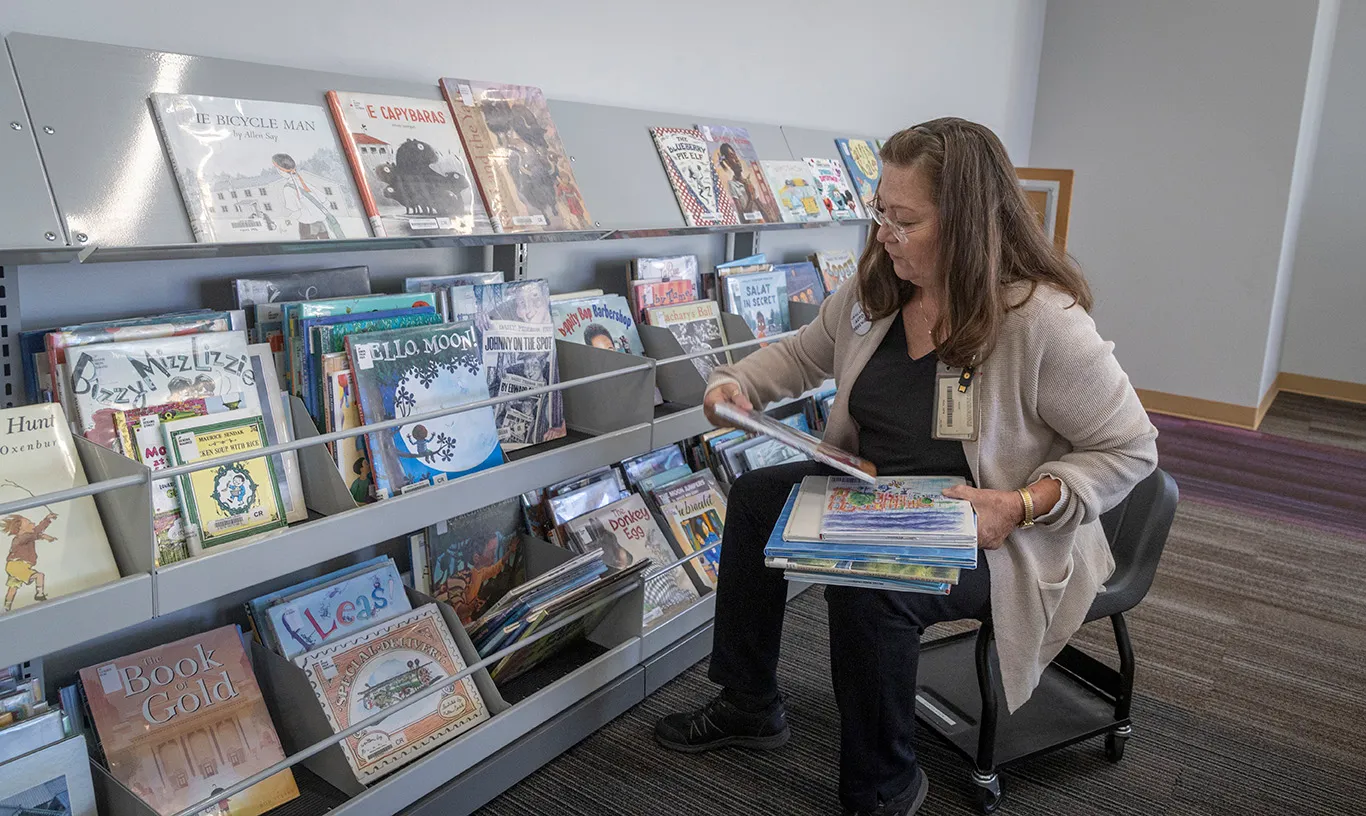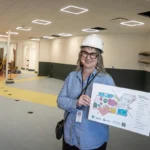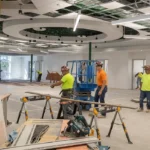Wichita is cutting back to ready for a budget shortfall in the coming years. To prepare, the City Council is sorting through spending items to determine what’s most essential. That will mean decreased funding for such things as Century II and the Wichita Ice Center, and moving money away from the program to pave dirt roads.
But the Wichita Public Library stands apart. It’s a sign that, after a period in which libraries were labeled as obsolete, there’s growing agreement that they play a vital role in the community.
Past budget cuts led to closures and the consolidation of library services, but as libraries continue to evolve, city leaders have recognized the vital role that they play.
As more people start to see them as essential for education, public safety and access to information, libraries are seeing an influx of capital spending. The recent push to complete the Wichita Public Library’s long-term building plans underscores this shift.
“The conversation really started in the mid-2000s when the City Council was asking, ‘With Google and the internet, what is the need for libraries?’” says Jaime Nix, Wichita’s director of libraries. “They have now decided we want a vibrant community space.”
The council’s $2 million library allocation to complete the Library Master Plan would seem to be evidence of that. Most of that money comes from the federal government, distributed through the American Rescue Plan Act, a $1.9 trillion economic stimulus bill passed in 2021.
Paul Hawkins is the director of the South Central Kansas Library System. He says that Wichita’s renovations are unique for the state.
“Other than a few small renovation projects in the region,” Hawkins says, “Wichita is doing something pretty special.”
Renovations at the Evergreen Library in north Wichita are finished. The Maya Angelou branch near Wichita State University is set to welcome a work crew when it closes for five months beginning in October.
Renovations of the Westlink branch should be finished in December, allowing for a reopening in February 2025. When it opens, the space will be almost 10,000 square feet and have more areas to serve the community and teens. Credit: Jeff Tuttle
The current status of the Westlink library renovation
Across town in the Westlink library, if a visitor could access the site, all they would find is a skeleton of what’s to come.
“We are in the bare bones stage,” says Lauren Hirsh, library board president. “It’s a lot of walls coming down, and walls going up.”
Included in Westlink’s future is more space – almost 10,000 square feet, allowing for expanded community spaces and an area dedicated to teens – automated checkout systems to free up staff, a new drive-up option and an art installation from a local artist.
The renovations should be finished in December, allowing for a reopening in February 2025.
“Everything is smooth, and I cannot wait to see a space that is reflective of what the community needs,” Hirsh says. “Westlink was my childhood library and seeing care put into it feels amazing.”
But Westlink’s renovations are only part of the picture. Like the Maya Angelou branch, plans for the Alford branch have been drafted. Construction on the Rockwell branch in east Wichita began in July. In the end, most of Wichita’s libraries will be renovated.
Why is Wichita bucking the trend?
Nationally, when cities face shortfalls, they often start cutting libraries. Wichita has been no exception.
The library has been forced to streamline operations to deal with a budget that’s hovered around $10 million in recent years and hasn’t kept up with inflation. To compensate, hours have been cut and some services now are offered only at specific branches. Nix says when budget cuts are deep, the only option left is to close a library branch.
Wichita made that choice at least two times in the recent past.
The City Council voted to close the Orchard Park Recreation Center branch in 2014. The small branch wasn’t very busy but had served the community for 34 years.
The council closed another location, the Comotara Branch, in 2018 when the space was no longer available.
The Comotara Branch, the first library branch to operate out of a grocery store in the country, was housed at the Dillons at 21st Street and Rock Road. Dillons let the city use the space for free, and Nix says it was a very popular location. Dillons wanted the space for an expansion, and the city couldn’t afford to move the branch.
The Library Master Plan had an original timeline of 2019 to 2023, but a year into the plan, the COVID-19 pandemic stalled progress. Then, a federal response to ensure public spaces were safe and sanitary provided Wichita’s libraries with their own shot in the arm. Credit: Jeff Tuttle
A reversal in policy
As the city closed the Comotara Branch, the library system faced another potential setback.
City Manager Robert Layton’s 2018 budget proposal recommended closing two branches, Evergreen and what is now known as Walters.
That proposal was upsetting to more than a few library patrons.
Former Wichita Mayor Carl Brewer chimed in saying the city should never have considered closing the branches.
The proposal was voted down. A year later, the city approved the Library Master Plan, a list of projects that included remodelings and renovations at nearly every branch and a relocation.
In 2024, a majority of council members supported increasing the renovation budget.
“It didn’t matter the party affiliation,” Hawkins says. “Almost all of the members have something good to say about Wichita’s libraries.”
COVID-19’s unexpected help with the Library Master Plan
The Library Master Plan had an original timeline of 2019 to 2023, but a year into the plan, the COVID-19 pandemic stalled progress. Then, a federal response to ensure public spaces were safe and sanitary provided Wichita’s libraries with their own shot in the arm.
Having ARPA money available allowed the scope and cost of the project to change. The first price tag was $5.3 million, paid for with general obligation bonds and federal grants. Using ARPA money, $10 million was committed to complete renovations at the Westlink, Alford, Maya Angelou and Rockwell branches. The initial city commitments were able to be rerouted elsewhere. The Wichita Public Library Foundation then moved into the funding picture with a $2 million gift. The final $2 million approved this year, almost all of it ARPA funds, is the capstone.
“The ARPA funding really allowed us to go back and ask, ‘If we could do this more fully, how would we?’” Nix says.
The library added parking and entryway upgrades, drive-thru book pickup and reservable workspaces for patrons to its initial plans.
•
• Fatima Moreno, a senior at East High School, studies at the Advanced Learning Library earlier this fall. Credit: Jeff Tuttle
• Wichita Public Library employees Alexander Chien and Alexis Ternes work in the AV room at the Advanced Learning Library. Credit: Jeff Tuttle
•
• Fatima Moreno, a senior at East High School, studies at the Advanced Learning Library earlier this fall. Credit: Jeff Tuttle
Fatima Moreno, a senior at East High School, studies at the Advanced Learning Library earlier this fall. Credit: Jeff Tuttle
Why improve Wichita libraries?
Wichita’s libraries offer residents a variety of services. Some branches focus on student learning, a valued resource for local schools.
Gail Becker, supervisor of libraries for Wichita Public Schools, says the city’s libraries have been great partners.
“They do a lot of work for us,” Becker says, “and a lot of collaboration.”
Wichita libraries offer after-school activities, curate books for the school district’s Battle of the Books and help pre-K students prepare for school with the 1,000 Books Before Kindergarten program.
Wichita’s libraries also provide space, computers and access to information that residents might not otherwise have. Library patrons use computers to apply for jobs, research government aid and make online medical appointments.
Hirsh, the library board president, says it’s all part of the library’s mission.
“We are looking at what people really need in the area,” Hirsh says.
The Evergreen branch, for example, provides Spanish-language services, helping people who speak the language to connect with the local government for assistance.
Libraries as crime prevention in Wichita
Along with each budget document, the City Council adopts a Capital Improvement Program, laying out infrastructure goals for the next decade. This year’s plan put a focus on crime prevention, including how libraries can improve community health.
Quality of life improvements provided by places such as the library can help decrease crime, according to the Capital Improvement Plan.
A study by the Institute of Museum and Library Services, a federal agency based in Washington, found libraries are “positively associated with multiple dimensions of social well-being – in particular, community health, school effectiveness, institutional connection and cultural opportunity.”
Wichita libraries have embraced their status as a “third place,” a space outside of work or home. Third places have been recognized as boosting community health and reducing loneliness in young adults.
“What I love about what’s happening with the libraries is they’re trying to expand who they can reach and how they can improve safety in the community,” Hirsh says. “Libraries can be used to help people that might be seeing cuts in other parts of their lives.”
First District City Council member Brandon Johnson is excited about the role libraries can play.
“Those who think it’s (crime prevention) just the Wichita Police Department, it’s not,” Johnson says. “It’s more. It’s libraries; it’s parks; it’s cultural arts.”
Jamie Nix, Wichita’s director of libraries, says the conversations about upgrades to library facilities began in the mid-2000s, when the City Council was questioning what purpose libraries should serve. That’s led to improvements, such as the ones unfolding in the Westlink branch. Credit: Jeff Tuttle
Learning from a nearby success
Wichita is not the only Midwest city to prioritize libraries. Omaha’s library system has seen a recent boon, increasing its budget and starting construction on a new central library. HDR and Alley Poyner Macchietto Architecture designed the striking structure, which is certain to be a city landmark.
Laura Marlane, the executive director of Omaha Public Libraries, says the support mostly came from outside city government.
“We are very lucky to have major donors in the area,” Marlane says. “And we were lucky they found importance in the libraries.”
A philanthropic group called Heritage Omaha is largely funding the construction of the 96,000 square foot building after raising over $150 million. According to its website, the new location is an “investment in literacy, digital equity, community development and individual potential.”
It echoes what Wichitans are hearing from many of their leaders.
Marlane says this shift in thinking – imagining libraries as more than places to find books – has helped solidify their future and their expansion.
“When people look at library budgets, they can fall into a trap,” Marlane says. “They ask ‘Why do we fund this if it doesn’t generate more money’? but that’s not the point.”
She notes that Omaha spends money on libraries not because they generate monetary value, but because it’s viewed as a way to fund community health – a perspective that’s shared widely in Nebraska’s largest city.
Heritage Omaha is not the only source of money for the library. Marlane says its operating budget mostly comes from the city government, much like Wichita’s. Omaha libraries also get money from state and federal grants and their own library foundation.
But unlike Wichita, Omaha receives money from the surrounding county as well.
Cost-cutting could still come to the library
For all the plaudits that have been earned by libraries in general and the Wichita Public Library in particular, there are those who think differently. Dalton Glasscock, who represents Council District 4 in Wichita and is a vocal supporter of consolidating government services, is one of those.
“I am interested in how we can think innovatively to save money,” he says.
His mission is to lighten the load on taxpayers and fund only essential services of city government, such as road maintenance, utilities and police. Libraries, while valuable, are not essential in his view.
Glasscock wants to find ways to reduce municipal operating costs and rely more on outside partners. That would shift the monetary burden away from taxpayers and save the city money.
He pointed to a recent push to add solar panels to city libraries as a way to save utility costs. In his opinion, the Wichita Public Library Foundation, the Friends of the Library and Wichita Genealogical Society are places that could provide outside support.
The future of the Wichita’s libraries
In light of the ongoing energy surrounding the Wichita library system, it’s worth remembering that budgets annually need balancing. Just four years ago, the City Council cut the library’s material budget, used to purchase books, as a quick cost-saving measure. Mayor Lily Wu says there are no current plans to cut the library’s budget and all renovation projects are expected to continue.
But challenges remain. According to Nix, the library’s materials budget is smaller than most libraries of its size.
The library has struggled to fill some of its open positions and has been relying on volunteers, who are becoming fewer. In addition,10 full-time positions have been lost since 2009.
While a larger operating budget could help fix these issues, the city’s political and budgetary trajectories could be pointing toward new fiscal priorities.
Could that mean cuts to the library budget? And if that were to happen, what would library usage look like?
“When we face economic hardship,” Nix says, “That’s when more people start using the library. I expect to see more people come to us as prices for things increase and some resources are cut back.”
Editor’s note: The Wichita Public Library is a partner in the Wichita Journalism Collaborative, of which The Journal is also a partner. The story was proposed and developed by a freelance reporter who does not participate in WJC meetings.
Trace Salzbrenner is a former Wichita resident and freelance journalist focusing on connecting government policy to the people affected.












